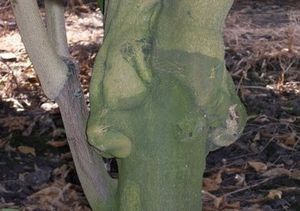Citrus rootstock facts for kids
Citrus rootstock are special plants. They are used as the bottom part of a citrus tree. Think of them as the strong roots and lower stem.
A citrus tree is made by joining two different plants together. This is called grafting. The top part, called the scion, is the part that grows the fruit. The rootstock is the part that grows the roots and helps the tree get water and nutrients.
The rootstock must be a good match for the fruit-producing part. It also needs to be tough. It should resist things like dry weather, frost, and common citrus diseases.
Main Types of Citrus Rootstock
Five main types of rootstock are used in warmer places. These include areas like Florida and southern Europe. These places usually do not have very cold or freezing weather.
- Sour orange: This is the only rootstock that is a true orange. It is a strong grower. It can also handle dry conditions very well.
- Poncirus trifoliata: This plant is a close relative of citrus. It is very good at resisting cold weather. It also fights off the tristeza virus and a root rot fungus. It grows well in rich, loamy soil. However, it grows slowly. It does not do well in hot or dry places. This rootstock is mostly used in China, Japan, and parts of California.
- Swingle citrumelo: This rootstock can handle the tristeza virus and root rot. It is also somewhat resistant to salt and freezing. Scientists created this rootstock in Florida in 1907. It was made by mixing a grapefruit and the Poncirus trifoliata. The US Department of Agriculture released it in 1974.
- Troyer citrange and Carrizo citrange: These are strong rootstocks. They resist root rot, tiny worms called nematodes, and the tristeza virus. They also handle cold well. A single seed can grow many plants, which is helpful for growers. But they do not grow well in clay or salty soils. They are not good for mandarin oranges. This is because they grow too many of their own branches. These rootstocks were first used in Australia in the 1960s. The Troyer type is common in California. The Carrizo type is used in Florida.
- Cleopatra mandarin: This rootstock can handle salty and alkaline soils. It also works well in shallow soils. It is mainly used in Spain, Australia, and Florida. For example, much of Dade County has a type of soil called calcareous soil. This rootstock was brought to Florida from Jamaica a long time ago. Today, it is not used as much. This is because it grows slowly and is sensitive to many diseases.
Other Useful Rootstock Types
Many other types of rootstock are used for citrus trees. Each one has special features. These features help citrus trees grow well in different places and conditions.
- African shaddock X trifoliate hybrid
- Benton citrange trifoliate hybrid
- Borneo Rangpur lime
- Bitters C-22 citrange
- Carpenter C-54 citrange
- C-32 citrange trifoliate hybrid
- C-35 citrange trifoliate hybrid
- Calamondin kumquat hybrid
- Carrizo citrange trifoliate hybrid
- Citradia trifoliate hybrid
- Citremon trifoliate hybrid (CRC 1449)
- Citrumelo trifoliate hybrid C190
- Citrumelo trifoliate hybrid (CRC 1452)
- Citrumelo trifoliate hybrid (CRC 4475)
- Citrus macrophylla (Alemow)
- Citrus volkameriana (Volkamer lemon)
- Cleopatra mandarin X trifoliate hybrid X639
- Flying dragon trifoliate (CRC 3330A)
- Fraser Seville sour orange
- Furr C-57 citrange
- Goutoucheng sour orange (CRC 3929)
- Goutoucheng sour orange (CRC 4004)
- Grapefruit seedling (CRC 343)
- Pomeroy trifoliate
- Rangpur lime X Troyer citrange hybrid
- Rich 16-6 trifoliate
- Rubidoux trifoliate
- Rusk citrange trifoliate orange hybrid
- Satsuma X trifoliate hybrid
- Schaub rough lemon
- Small-leaf trifoliate
- Smooth Flat Seville sour orange
- Sun Chu Sha Kat mandarin
- US 119 (Grapefruit X trifoliate) X Sweet Orange hybrid
- Vangassay rough lemon
- Yuma Ponderosa lemon pummelo hybrid
- Zhuluan sour orange hybrid (CRC 3930)
- Zhuluan sour orange hybrid (CRC 3981)


